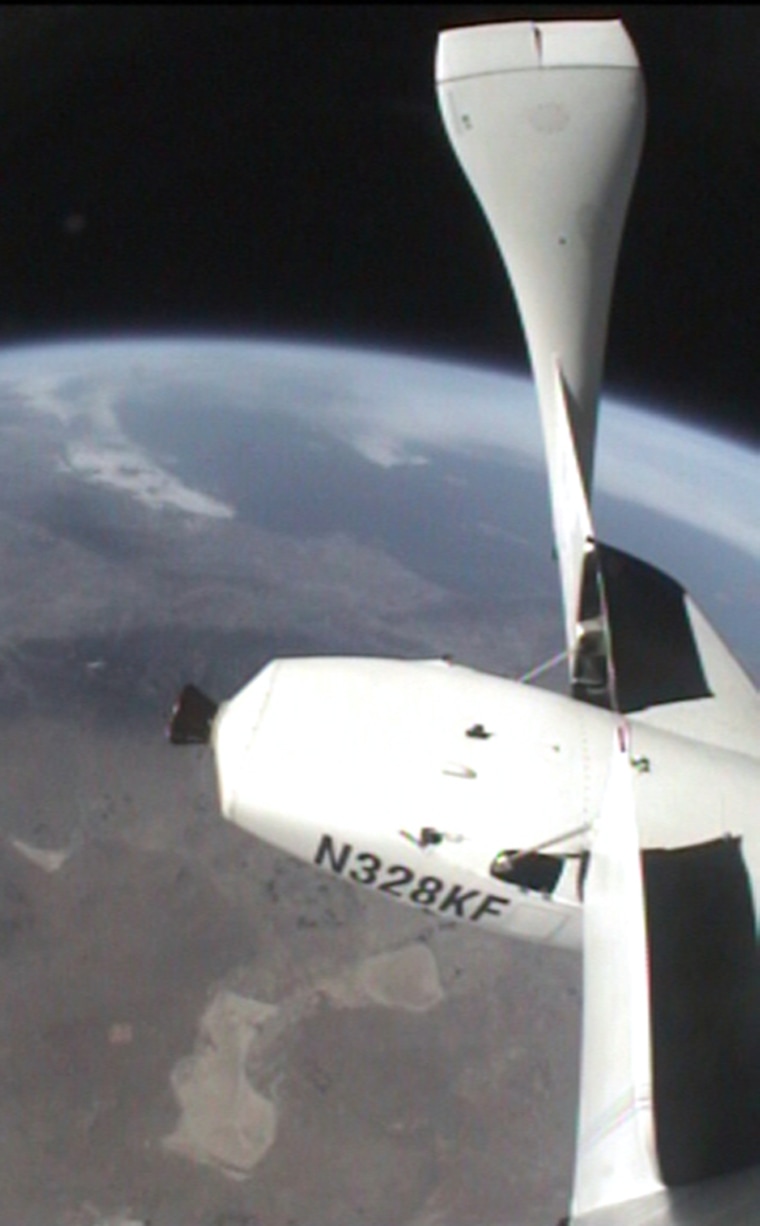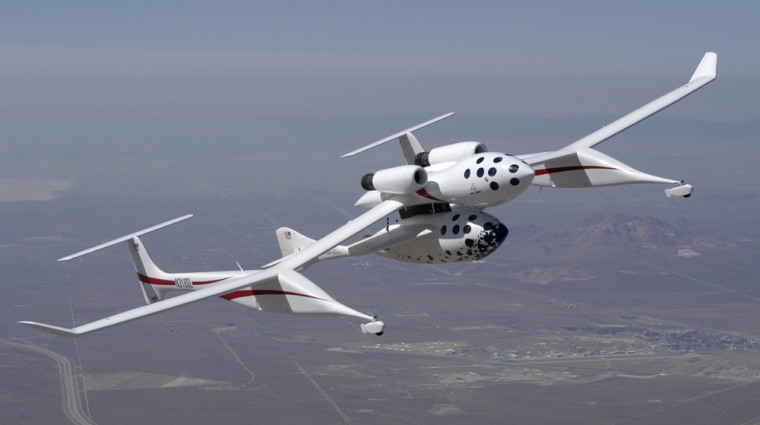Think of it as an elaborate badminton shuttlecock. Put a pilot in it, take it up in the air and fire it 62 miles straight up into suborbital space at three times the speed of sound — a spectacular trip undertaken with the knowledge that as the spacecraft plummets back to Earth, it will always be pointing in the right direction.
This elegantly simple precept underpins the aerodynamics of SpaceShipOne, a stubby rocket plane whose creators on June 21 plan to put a human in space for the first time without any government sponsorship or assistance.
"We are encouraging people to come and bring kids," said engineer Burt Rutan, who built SpaceShipOne. "We fly to space directly over the crowd instead of going way down range, and it lands back in the same place like a small, light plane at a private airport."
Rutan leads one of 27 teams from seven countries that are competing for the $10 million X Prize, to be given to the first private entrepreneur who can put three people into suborbital space and do it again with the same equipment within two weeks — and do it by the end of this year.
The idea is to create a new tourist industry. "For the last 30 years, people have thought that space flight is only for a select number of government employees," said Peter H. Diamandis, chairman and president of the X Prize Foundation, the competition's organizer. "We want to change that mind-set."
Changing perceptions
The X Prize is modeled on the $25,000 Orteig Prize that Charles Lindbergh won for crossing the Atlantic nonstop in 1927. Practically overnight, the narrow public perception of the airplane as a weapon and a stunt device expanded to embrace air travel as something for Everyman .
"So if Burt Rutan can do it with a couple of dozen people, there will be a lot of investment," Rutan said, speaking by telephone from his Mojave, Calif., headquarters. "In 12 to 15 years, we'll have suborbital space tourism that costs as much as a luxury cruise, and very soon after that, you'll be able to spend your vacation in orbit."
Also, Diamandis added in a telephone interview from Santa Monica, Calif., the X Prize serves to "to create a business model," to show that the private sector can fly to space for only a fraction of the hundreds of millions of dollars that it costs for a NASA space shuttle mission, or even the estimated $20 million that space tourists Dennis Tito and Mark Shuttleworth paid to ride on the Russian Soyuz.
Rutan, who gained widespread renown in 1986 when his Voyager became the first aircraft to circumnavigate the globe without refueling, estimates that commercial suborbital flights could cost $30,000 to $50,000 "initially," and as little as $7,000 to $12,000 in a "second generation."
Eyes on the prize
He works at his Scaled Composites company next to a small municipal airport in Mojave, where the June 21 flight will take place. The team is funded by Microsoft co-founder Paul G. Allen, who said he has spent "in excess of $20 million" on SpaceShipOne. Although the project "is a very exciting, cool thing," he added, "Don't think [the prize money] is not a component — it's going to cut our costs in half."
Although the flight, if successful, will be history's first privately funded manned space flight, it will not qualify for the X Prize, because it will have only the pilot aboard. The prize flights will follow shortly, Rutan said. He has not named the pilots.
At the moment, Rutan is the leading X Prize contender, but there are a half-dozen others close behind, especially the Canada-based Orva Space Corp., developers of the Da Vinci Project. It features a giant, helium-filled balloon that will release a rocket 80,000 feet above Earth for a burn into suborbital space.
"Burt [is ahead of] us right now," Canada's Brian Feeney, president, pilot and co-owner of Orva Space, said in a telephone interview from Scarborough, Ontario. "But we're feeling very competitive, and we're going to go sometime this summer."
Feeney noted that while Rutan has, in Allen, one of the world's richest men for a sponsor, Da Vinci is being developed on a shoestring by volunteers, with help from in-kind corporate contributions. And while the 220-foot-wide balloon may be awe-inspiring, Feeney said its chief attraction is low cost.
Capturing the imagination
Feeney and Rutan are friendly rivals, and as the contest nears a climax, it is clear that the X Prize has captured the imagination of aerospace mavens everywhere.
"If you can prove you can do this safely, you're opening a new industry," Kevin B. Marvel, deputy executive officer of the American Astronautical Society, said in a telephone interview. "It's real, it makes sense, and it's looking way forward. When I first heard about it I thought, 'yeah, right,' but they've convinced me."
The "prize model" has also drawn interest from NASA, which is hosting a conference next week on how to use similar competitions to enlist private know-how in overcoming hurdles posed by President Bush's proposal for exploring the moon and Mars.
"We see prizes as a good way to do that," said Brant Sponberg, program manager for Centennial Challenge, NASA's prize initiative. The agency has asked for a budget of $20 million for it in 2005.
Sponberg is contemplating contests including "land ten kilos [23 pounds] on the moon very cheaply," and "develop a system to land very precisely on the moon or Mars" without a satellite navigation system. "I'm sure there's some genius kid out there who can probably figure it out." he said.
New wrinkles to old technologies
Many of the X Prize entries add new wrinkles to old technologies. The Canadian Arrow team has modeled its rocket engine after the 60-year-old German V-2. Feeney's rocket has a rounded head, whose ballistics are similar to those of a 45-caliber bullet.
Rutan acknowledged that SpaceShipOne draws inspiration from the X-15, the experimental hypersonic rocket plane that flew 199 times between 1959 and 1968, reaching a height of 67 miles and enabling eight test pilots to earn astronaut wings for exceeding the Air Force's "space" altitude requirement of 50 miles.
The X-15 began its burn after launch from a B-52 bomber, used thrusters to steer itself in space and glided to a landing after reaching speeds as high as Mach 6.7 (4,534 mph). SpaceShipOne piggybacks aboard a wispy mother aircraft known as the White Knight, also uses thrusters and glides to a landing.
"It's not that hard, in the sense that while [SpaceShipOne] is entering space, it's not entering orbit," a much more difficult exercise, said aeronautical engineer Edward F. Crawley of the Massachusetts Institute of Technology.
"But that's not the point here," added Crawley, another X Prize enthusiast. "The question is: If you've been to 100 kilometers [62 miles], seen the curvature of the Earth, seen the darkness of space and experienced weightlessness, could you say you'd been in space? Absolutely. And it would be the thrill of a lifetime."
Also, once past the surface similarities, SpaceShipOne has little in common with its ancestor. "The X-15 was a government research plane for high speed," Rutan said. "Their goal was not to go high, even though they could."
Secret of SpaceShipOne
SpaceShipOne's secret is that it can go almost straight up and come almost straight down at relatively low speed, whereas the X-15, traveling much faster, took more oblique trajectories that sent the aircraft hundreds of miles down range to land. One thing that makes re-entry less stressful is that SpaceShipOne, made of graphite composite, weighs only "6,000 to 7,000 pounds," Rutan said. The X-15 was made of titanium and weighed 50,000 pounds.
"SpaceShipOne is designed to re-enter at a high angle, a breakthrough that has never been used before," said William H. Dana, one of the X-15 test pilot-astronauts and a retired chief engineer at NASA's Dryden Flight Research Center, in Edwards, Calif. "I don't know that Burt invented this, but he's the first to put his money where his mouth is."

Once released by White Knight at an altitude of 48,000 feet, SpaceShipOne's rocket engine burns for 80 seconds, accelerating the aircraft at three times the force of gravity to reach a speed of Mach 3.2 (2,400 mph) by the time the engine burns out at 160,000 feet.
"We coast the rest of the way," losing power and slowing down, Rutan said. At 200,000 feet, the pilot — and passengers in the future — experience weightlessness, which lasts three to four minutes as the spacecraft attains its maximum altitude of 340,000 feet (62 miles), virtually stops, then falls back to 200,000 feet, when it begins to feel the atmosphere once again.
"Early on, I recognized that re-entry is the biggest risk," Rutan said. The key, he explained, is to decelerate gently in the upper atmosphere by controlling SpaceShipOne's angle during descent and maximizing drag, making for a much safer and more comfortable ride for space tourists.
To do this, SpaceShipOne reconfigures its wings — Rutan calls it "feathering" — which slows the spacecraft even as it automatically aligns it in the proper flight path. This is the shuttlecock effect -- SpaceShipOne is always pointed properly during descent, holding the maximum descent speed to about Mach 2.5 (1,900 mph).
And "by 80,000 feet, we're essentially done," Rutan said. The pilot readjusts the wings, and the aircraft becomes a glider and coasts home.
